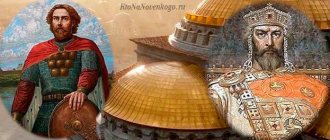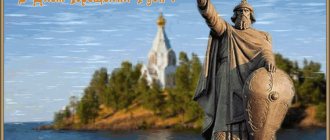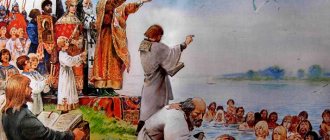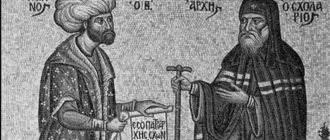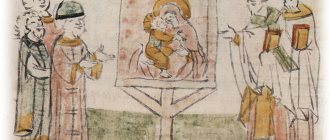The year 988 became a conventional milestone that divided the history of Ancient Rus' into “before” and “after”. In the 11th century, paganism tried to regain lost ground.
“Volodimer sent an ambassador throughout the city, saying: “If anyone does not appear in the morning at the river, whether rich, or poor, or poor, or a worker, let him be disgusted with me.” Hearing this, the people walked with joy, rejoicing and saying: “If this had not been good, the prince and the boyars would not have accepted this”…” - this is how the author of “The Tale of Bygone Years” described the baptism of the Kievites.
In a single impulse, the residents of the capital, following the example of their benefactor-prince, stepped into the waters of the Dnieper and abandoned their pagan past. However, the reality turned out to be not as rosy as the chronicler outlined in his work. Before completely conquering the minds of the inhabitants of the state, Christianity had to fight with paganism that was still afloat.
Christianity before baptism: the first attempts of princes to baptize Rus'
The first Christians found themselves in Slavic settlements and trading posts already in the 9th century, and possibly earlier - in any case, archaeological finds of characteristic ritual artifacts in Staraya Ladoga, where the semi-legendary Rurik would arrive, date back to this century.
Fossil data correlates well with reports from written sources, according to which some “Rus” adopted Christianity in the middle - second half of the 9th century: these events are often associated with the reign of Askold and Dir in Kyiv.
Engraving by F. Bruni “The Death of Askold and Dir.” Source: Essays on events from Russian history, composed and engraved by professor of painting F. Bruni
By the 10th century, a large number of Christians lived in Kyiv and Novgorod, the largest cities of the united state created by the Prophetic Oleg. This is also confirmed by the results of archaeological excavations. Important changes in the religious composition of the population of Ancient Rus' also coincide with the key political event of that period - the adoption of Christianity by Princess Olga, the widow of Igor Rurikovich, killed by the Drevlyans.
Baptism of Princess Olga. Source: wikipedia.org
Already at this time, serious problems associated with Christianity were emerging. In 959, the German Bishop Adalbert of Magdeburg went to Rus' - this visit was the result of satisfying the request of Princess Olga addressed to the Emperor of Germany Otto I, regarding assistance in the spread of Christianity in Russian lands. However, the mission of the clerics was not successful. After some time, the bishop returned to his homeland, and some of his associates were killed by pagans - it is believed that not without the participation of Olga’s son, Svyatoslav.
New attempts to establish contacts with religious leaders of the West were recorded during the short-term reign of Yaropolk Svyatoslavich, the brother of the future baptist of Rus'. In 979, he turned to the Pope with a request to send clergy to Kiev for sermons, which managed to turn against himself not only the pagan circles of the capital, but also the Christians living in the city, who gravitated towards eastern practices of confession of faith. This short-sighted step largely predetermined the defeat of Yaropolk in the fight against Vladimir.
Yaropolk Svyatoslavich surrounded by his squad. Source: commons.wikimedia.org
Reasons for the adoption of Christianity by Prince Vladimir
It is impossible to say anything for sure about the motives of Vladimir’s actions. But it can be assumed that the prince, who was actively expanding and strengthening his state, wanted to give it more weight in the international arena. In the process of contacts with neighbors, he had the opportunity to make sure that they accepted religions with faith in one god, and not in many, as in Rus' (the Khazars professed Judaism, the Volga Bulgars - Islam, Rus''s neighbors in the south and west were Christians).
Hence the assumptions of historians that Vladimir, by changing his faith, wanted to provide himself with an additional factor of centralization of the state (one god - one prince). He also became convinced that the paganism of Rus' prevents other peoples from treating it with due respect and perceiving it as their equal.
There is another important factor: Byzantium actively encouraged the prince to take such actions. The policy of the empire was to spread Christianity to as many nations as possible and in this way force them to recognize their dependence on Constantinople. The significant military strength of the Slavs (who dealt sensitive blows to the empire) required measures to be taken.
Vladimir also agreed on the baptism itself through the use of force - the agreement was reached after the capture of Prince Korsun (Chersonese Tauride) by the army. For this reason, the conditions for the Christianization of Rus' were quite favorable - without official political dependence on Byzantium.
Vladimir Svyatoslavich and the baptism of Rus'
Vladimir Yaroslavich, who won the internecine war, did not initially plan to spread Christianity to Rus' - baptism was preceded by an attempt to unify pagan cults in the lands controlled by Kyiv. Perun was declared the supreme god, and pagan temples were erected. But the reform did not achieve the desired result: the unification of the lands was hampered by the variety of cults, not all of which recognized the supremacy of Perun. It was then that Vladimir thought about converting to one of the monotheistic religions.
In the chronicles, these thoughts (or, rather, ideas about them) were reflected in the legend of the “Test of Faith.” Of course, in reality, there were no clergy embassies to Vladimir’s court in a short period of time, but the legend quite reliably conveys the atmosphere in which Vladimir was forced to make a decision about the spiritual future of his subjects. The choice fell on Byzantine-style Christianity - Rus' had long had fairly close contacts with the Eastern Roman Empire.
There is still debate in historical scholarship regarding the specific time of the baptism of Vladimir and the people of Kiev. The generally accepted date is disputed by scientists: many researchers date the prince’s conversion to Christianity to 987, and the events in Kyiv to 990. However, the main events are not controversial. Vladimir's support of Constantinople in the fight against the uprising of Bardas Phocas, his courtship to Princess Anna and the siege of Korsun really happened. As well as sending missionaries to the capital of Rus'.
Arrival of Byzantine missionaries in Kyiv. Source: wikipedia.org
The idyllic picture of the baptism of Kiev residents also raises doubts. Thus, church history researcher Oleg Rapov points out that not all residents of the capital agreed with the changes in the spiritual life of the state. Many supporters of paganism, as a sign of protest against the princely policies, left the city for the forests and actively resisted the introduction of Christianity. Events in Kyiv clearly showed that the Christianization of Rus' would last for many years and would be accompanied by violent clashes in an attempt to protect pagan temples and the right to practice pagan cults.
The significance of the introduction of Christianity in Rus'
The historical significance of the introduction of Christianity in Rus' was to introduce the Slavic-Finnish world to the values of this religion, to create conditions for full cooperation of the tribes of the East European Plain with other Christian tribes and nationalities.
Rus' was recognized as a Christian state, which determined a qualitatively different, higher level of relations with European countries and peoples. Christianity in Rus' was a force that united the inhabitants of different lands into a cultural and political community. Christianity, with its teaching about the divinity of power, strengthened the power of the prince, the existing system and the Old Russian state as a whole:
Thanks to Christianity, Rus' got the opportunity to become more familiar with the higher Byzantine culture and accept the heritage of antiquity. On the basis of this knowledge, Russian medieval culture was created. Its originality and high level were due to the unified literary Slavic language in which church services were conducted. From the gradually mastered achievements of Byzantium grew stone architecture, iconography and fresco paintings, hagiographic literature and chronicles, schools and the correspondence of books, previously unknown to the Eastern Slavs.
The church played a major role in the development of the Old Russian state. There was a close union of secular and ecclesiastical authorities; this later became a tradition of Russians. The Church brought writing to Rus'. After all, it was Church Slavonic writing that served as the basis for the development of Russian writing for the development of the Old Russian literary language - thus, the church laid the foundations of national Russian culture.
Baptism of Novgorod: on the threshold of civil war
Problems arose already at the first stage of the spread of Christianity - Veliky Novgorod became a center of resistance. The religious issue was closely intertwined with the political: noble people of the former capital of Rus' were wary of the will of Kyiv, seeing in baptism a possible weakening of their independence. Vladimir was also aware of the problems, so in 990 a military expedition under the leadership of Voivode Dobrynya, the uncle of the Kyiv prince, set off to the north-west of the country.
Initially, Dobrynya and clergy sent from Kyiv baptized several hundred Novgorodians who agreed to this event in order to convince the local population of the correctness of this decision. The following year, during a new campaign, the Novgorodians, led by the thousand Ugonai and the sorcerer Bogomil, decided to resist the Kievans. An uprising began, during which the pagans destroyed the house where Dobrynya was located. He decided to act quickly - it was the surprise of actions that could ensure his victory over the superior forces of the rebels.
His comrade Putyata tied up the superior forces of the Novgorodians in battle, and at this time Dobrynya himself began to burn the houses of the pagans. The fire quickly spread among the wooden houses, which forced the rebels to negotiate with the people of Kiev. At a citywide meeting, city residents allowed the construction of churches in Novgorod and promised not to interfere with Christian preachers, but a very small number of citizens wished to be baptized.
This did not suit Dobrynya - he began to carry out religious rituals by force, using his troops, and also destroyed pagan sanctuaries and temples. The people of Kiev celebrated the victory. And although many Novgorodians adopted Christianity only out of fear of the authorities - for a long time pagan gods were secretly revered in the city - nevertheless, Vladimir Svyatoslavich celebrated his victory: he managed to subjugate the second most important city of the state to his will.
Modern view of the Volkhov River, where Novgorodians were baptized. Source: wikipedia.org
The process of baptism of Russian lands dragged on for decades. In fact, only residents of large cities converted to the new faith, but their loyalty was often subject to great doubt. The border territories of the state remained pagan for a long time: for example, the Vyatichi tribe refused to convert to Christianity, according to some sources, until the 14th century.
After the baptism, the former pagan clergy and sympathizers of Perun went underground. Temples were erected throughout the country, and clerics arrived from Byzantium to train clergy from the local population. The Magi were just waiting for an opportunity to show themselves in all their glory, and such opportunities were repeatedly given to them throughout the 11th century.
Magus Fantasy of a modern artist. Source: commons.wikimedia.org
The first major uprising took place in Suzdal in 1024, when the region was struck by a terrible crop failure and drought: there was not enough food, and ordinary people tried to find the culprits of the bad weather. The Magi were near them in time: they blamed the tribal nobility for all the troubles. According to pagan traditions, the guilty were sacrificed to appease the gods. This is what the rebels did, simultaneously putting elderly people to death in order to “renew” the earth. Yaroslav the Wise did not react in any way to the speech of the residents of Suzdal - the uprising died out on its own.
The most famous pagan performances occurred 50 years after the events in Suzdal. In 1071, the people of Rostov and Novgorod rebelled, and the rebellion happened for exactly the same reasons as in Suzdal - drought, crop failure and distrust of noble people who, it seemed, were hiding food supplies. In both cases, the performances were led by Magi who emerged from underground. This suggests that the pagan faith was still deeply rooted in the people, because a little less than a hundred years passed after the baptism of Rus'.
In Novgorod, according to the Tale of Bygone Years, in 1071 a nameless sorcerer appeared on the streets of the city and began to agitate the local population against the local bishop. The chronicler reports that only Prince Gleb and his retinue remained on the side of the Christian cleric - 80 years after the city was baptized by Dobrynya, the overwhelming majority of the townspeople sympathized or at least were sympathetic to pagan cults.
Street fighting almost broke out in Novgorod, but the prince quickly stopped a possible attack by simply killing the sorcerer. It is interesting that after the death of the leader, the dissatisfied simply went home.
Andrey Ryabushkin. Prince Gleb Svyatoslavovich kills the sorcerer at the Novgorod Assembly. 1898 Source: commons.wikimedia.org
In Rostov, also against the backdrop of crop failures, in 1071 two wise men from Yaroslavl appeared and began to brand Christian clergy and the local nobility - they say that they are to blame for all the troubles that befell the common people. Having gathered a certain number of associates, the pagans began to destroy the surrounding churchyards, specifically pointing out noble women, accusing them of hiding food. Soon the rebels reached Beloozero, where Jan Vyshatich, the governor of Prince Svyatoslav Yaroslavich, was located. The rebels and Jan's detachment clashed near the city, but the battle ended in nothing.
Then the governor turned to the residents of Beloozero and demanded that they deal with the Magi on their own while his detachment collected tribute. The townspeople soon complied with the request of the princely envoy; the pagan clergy were caught, interrogated, and then handed over to the relatives of the murdered women.
Sergey Ivanov. Jan Vyshatic and the pagans. 1912 Source: commons.wikimedia.org
The Suzdal, Novgorod and Rostov events turned out to be the largest uprisings of the 11th century. However, chroniclers also reported a surge in robbery on the roads: “dashing people” became a headache for the princes at the turn of the 10th and 11th centuries. Apparently, religious changes, coupled with constant civil strife, became one of the reasons for the deterioration of the situation in the country. The Baptism of Rus' divided society for many decades.
Christianity in the 10th and 11th centuries was able to gain a foothold in the large cities of Ancient Rus', which nevertheless did not prevent local residents from periodically rebelling under the leadership of pagan priests. In rural areas and regions remote from trade routes, the situation was even more complicated. It can be reconstructed using data obtained through archaeological excavations. Artifacts discovered in the burials suggest that dual faith reigned among most of the population: Christian rituals and relics coexisted with pagan ones.
An echo of this phenomenon can be observed to this day: people celebrate Maslenitsa, celebrate carols, and jump over the fire on Midsummer Day. “Holy Rus'” was never able to completely rid itself of its pagan past.
Methods of carrying out religious reform and resistance to it
As already mentioned, the Russian population did not experience any special desire to become Christians. Therefore, the prince had to implement his plan by force.
The chronicle (despite its Christian character) states that the people of Kiev were forced into the Dnieper for baptism, and many people drowned. Vladimir began the process with large cities, but, for example, Novgorod showed desperate resistance to the expansion of the new religion. Written sources contain references to how Dobrynya (the prince’s maternal uncle and his teacher) “baptized Rus' with fire” - the prince’s warriors burned the temples along with the wise men and other supporters of the faith of their ancestors defending them.
Major uprisings against forced Christianization were noted after Vladimir's death. They took place in Murom, Yaroslavl, Rostov even during the time of the heirs of Yaroslav the Wise. The last major pagan uprising in Novgorod occurred in 1070, and Rostov was finally baptized in 1078. In many ways, these uprisings revealed a general dissatisfaction with the Kyiv dictatorship rather than a desire to necessarily defend the pagan faith, although this factor also took place - as a reaction to the mass vandalism of Christianizers who desecrated temples and killed the Magi.
Already Vladimir began to create a Christian infrastructure in Rus' - to build churches, establish church administration, train his own priests (before that they were the Byzantines) and Christian literature. However, the structure of the Russian church was completely formed under Yaroslav the Wise. At the same time, the transformation of the church as a structure into a large feudal landowner and authority took place.
Spreading knowledge about religion
The Kiev throne came into the possession of Yaroslav the Wise, who was also the son of Vladimir. The new prince sought to enlighten the Russian people and strengthen the Christian faith. Yaroslav had great authority in his homeland and in European countries; he wanted to raise the status of Rus' to the level of the brilliant Byzantium.
The educational mission was extremely important for the young culture of the Russian people . Knowing that the country could become morally isolated and wild if it continued to stay away from spiritual centers, Yaroslav the Wise established relations with states that had a rich experience of religiosity.
- The prince received foreign Christian ambassadors in his chambers and sought to adopt the best customs. He diligently distributed spiritual literature.
- Greek, Bulgarian and Serbian clergy came to domestic monasteries, bringing church utensils, ancient writings, books on worship, which they soon began to translate.
- In Rus', the position of scribe appeared, whose job was to census the Sacred Texts. Christianity became a zealous educator of the Russian people, people were taught to read and write everywhere.
- Prince Yaroslav founded a large library in which everyone could find the necessary theological knowledge. The ruler gave priests aids for preaching and created Sunday schools.
- The prince created a moral Charter, in which the reader found legislation for moral behavior. The Russian people, studying Christianity, changed their own vision and rethought their attitude towards good and evil.
- His son Svyatoslav II continued his father’s work and published a religious “Izbornik”, which contained excerpts from the works of the Ecumenical Teachers, Augustine, John of Damascus and others.
In Rus', the position of scribe appeared, whose job was to census the Sacred Texts
Christianization and events preceding it
Few people ask the question: “what events preceded the adoption of Christianity”? But at the same time, this question is very interesting, since the baptism of the Old Russian state was preceded by truly interesting and even legendary chronicle legends.
This is interesting: how did Islam establish itself among the Arab tribes?
Before the adoption of Christianity, Vladimir Svyatoslavich tried to “breathe life” into paganism, to bring scattered beliefs, the worship of Mokosh, Perun, Dazhdbog, Volos and others into something holistic, capable of uniting the disparate East Slavic tribes.
He tried to build a pantheon of gods with Perun, the thunder god, lord of thunderclouds, heading it. But this idea, successful from the prince’s point of view, turned out to be a failure and did not lead to any significant unification of the tribes. People continued to pray to their patron gods of a particular craft, the protectors of certain tribal formations.
It was then that he began to think about converting his state to a monotheistic faith. We can learn about this from the Tale of Bygone Years, which is so significant for our state, which was written by the legendary monk of the Kiev-Pechersk Monastery Nestor.
This is interesting: the official first mention of Moscow, the year the city was founded.
From the Tale of Bygone Years we learn that ambassadors from Volga Bulgaria, Rome, the Khazar Khaganate and Byzantium were invited to Rus'. These states represented Islam, Catholicism, Judaism and Orthodoxy.
It is immediately worth noting: there was no division between Catholicism and Orthodoxy at that time, since only the Ecumenical Council of 1054 finally approved the division of the two churches into the Western - with the center in Rome - and the Eastern (with the center in Constantinople). But for convenience, we accept such a division, since already at that time a serious split was emerging.
What Vladimir answered to each of them can be found in the table below.
| State | Quote from Vladimir Krasno Solnyshko |
| Volga Bulgaria (Islam) | “Rus' has joy in drinking” - in response to significant restrictions on the consumption of wine, the ban on eating pork, etc. The proposal was rejected. |
| Rome (Catholicism) | “Go where you came from, since this was not accepted by our fathers” - prince to Latin foreigners. |
| Khazar Khaganate (Judaism) | “You don’t have your own land and shelter, so why should I convert to your faith?” - Vladimir asks a logical question to the Khazars who were scattered. |
| Byzantium (Orthodoxy) | Vladimir, having listened to the Byzantine who had arrived to him, said that he needed to “think again, for rashness in choosing faith can be punishable.” |
And although Vladimir Svyatoslavich liked the faith of the Byzantines, he decided, together with the boyars, to resort to another test: to send people to the Latins, Muslims and Greeks to observe the sacrament of the worship they performed.
The ambassadors returning from Constantinople thoughtfully said: “Having attended the divine service, we did not know where to eat - in heaven or on earth.” And the prince made a choice in favor of Christianity according to the Greek rite. At this point, the events that preceded the adoption of Christianity by Russia are considered.
This is interesting: 1240 is a significant event in Rus'.
Baptism of Kyiv
Returning to the capital, the prince began an energetic baptism; his sons and other close associates were the first to accept Christianity. At the same time, pagan temples (sanctuaries) were destroyed, statues of pagan gods were chopped up with axes and burned. The idol of the supreme god Perun was thrown from its pedestal, tied to the tail of a horse and dragged to the Pecheneg rapids; along the way, 12 soldiers beat it with sticks to get rid of the demons.
After this, the prince ordered all Kiev residents to gather near the banks of the Dnieper, where a mass baptism took place; hundreds of people simultaneously entered the water, where they were baptized by priests who had arrived with Anna from Chersonesus.
Baptism of Rus'
******************
After Kyiv, residents of other Russian cities were baptized in a similar way. True, baptism did not take place peacefully everywhere; for example, in Novgorod, local pagans showed fierce resistance, not wanting to accept Christianity and give offense to pagan idols. It is interesting that the suppression of the uprising of the Novgorod pagans was led by a certain Dobrynya Nikitich, who was one of the governors in the service of Prince Vladimir; he would later become one of the epic heroes. As for the real historical Dobrynya, the chronicler wrote the following about him: “They cross with the sword, and Dobrynya with fire.” That is, baptism was not voluntary everywhere; it is quite possible that in some places it took place with a sword at the throat. But such were the customs in those medieval times.
Gradually, Christianity became the state religion of Kievan Rus, but paganism also did not immediately disappear; at first, pagan magicians acted underground, and many people continued to secretly observe pagan rituals. To level out their actions, many pagan holidays were combined with Christian ones. For example, the purely pagan holiday of Kupala was dedicated to St. John the Baptist and began to be called Ivana Kupala, but this holiday itself is an echo of those distant, pre-Christian, pagan times.




